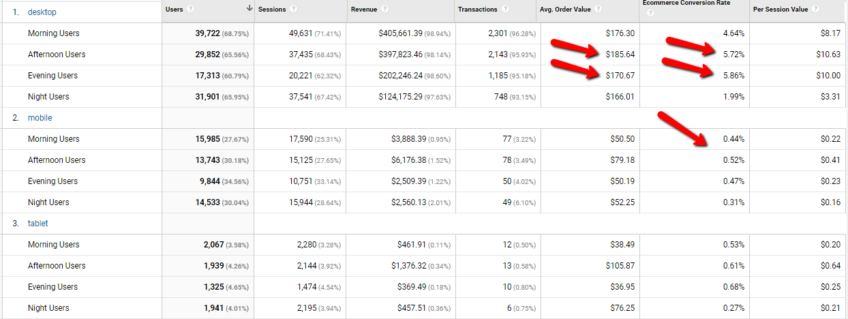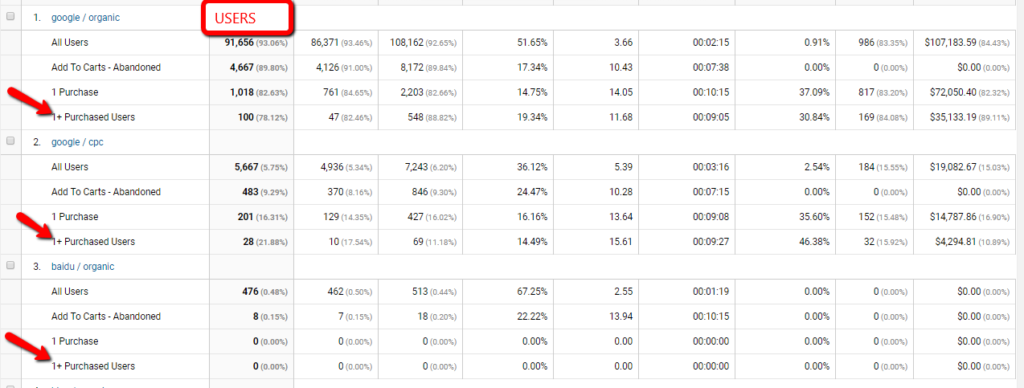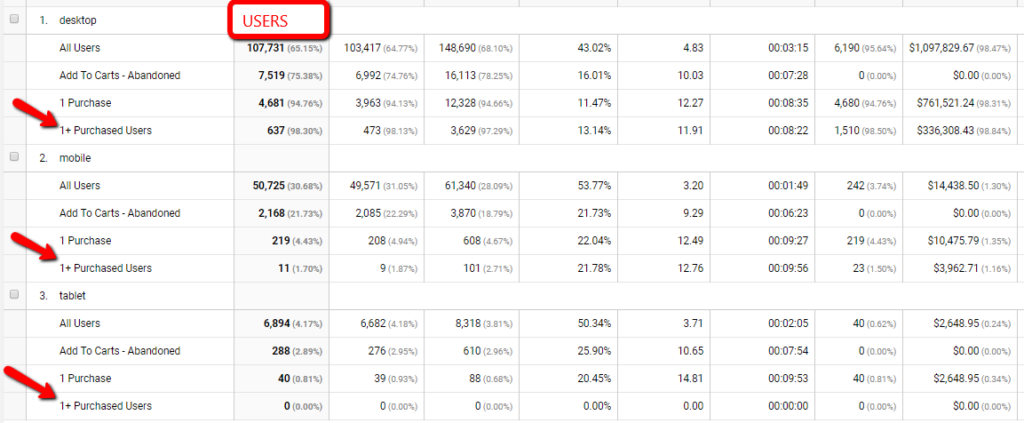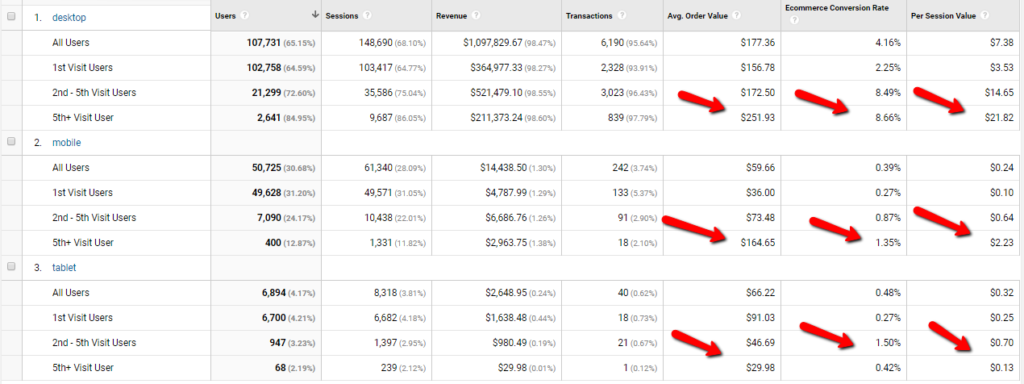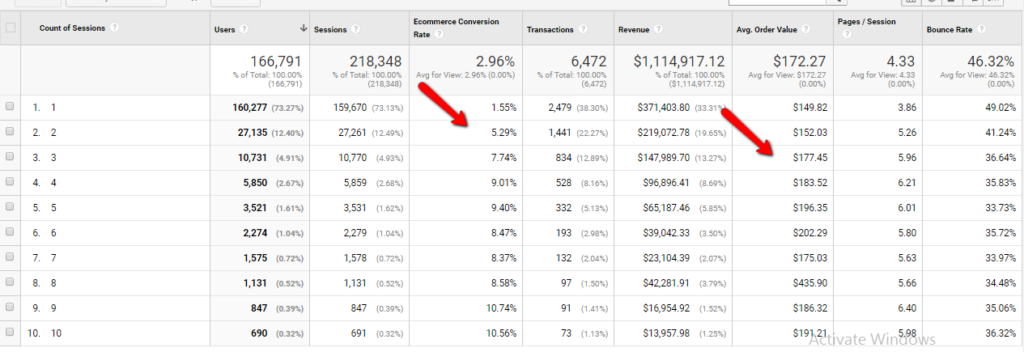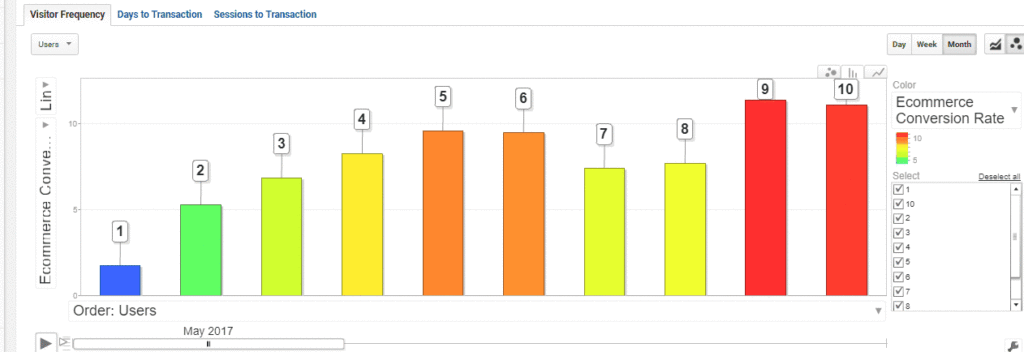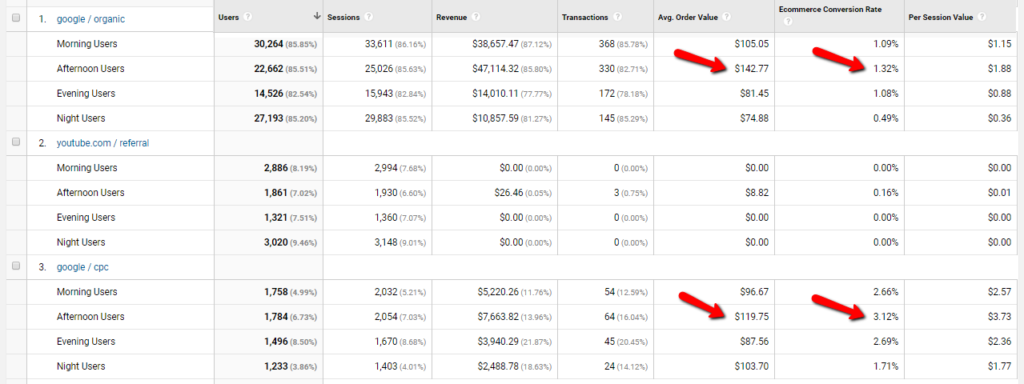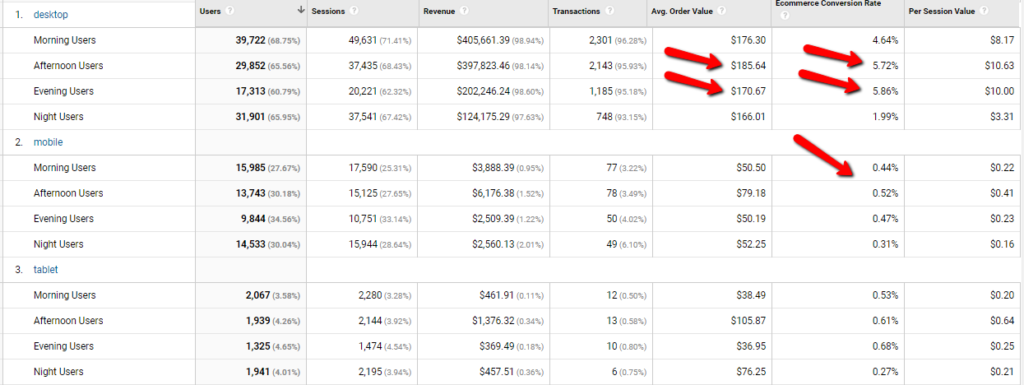The real power of Google Analytics is in the segments
No Segmentation, No Analysis……
If you really want to deep dive & focus on increasing your ROI, then follow these techniques.
Many of them fail to realize the power of real web analytics.
I’ll start with some of the usecases & also explain how to apply segments in google analytics.
User & Session Segment Example
Before starting just a glimpse of what user & session segments are-
Segments are subset of your analytics data.
So here’s an example, Let’s say there are 2 users who had 2 sessions each on a particular date range.
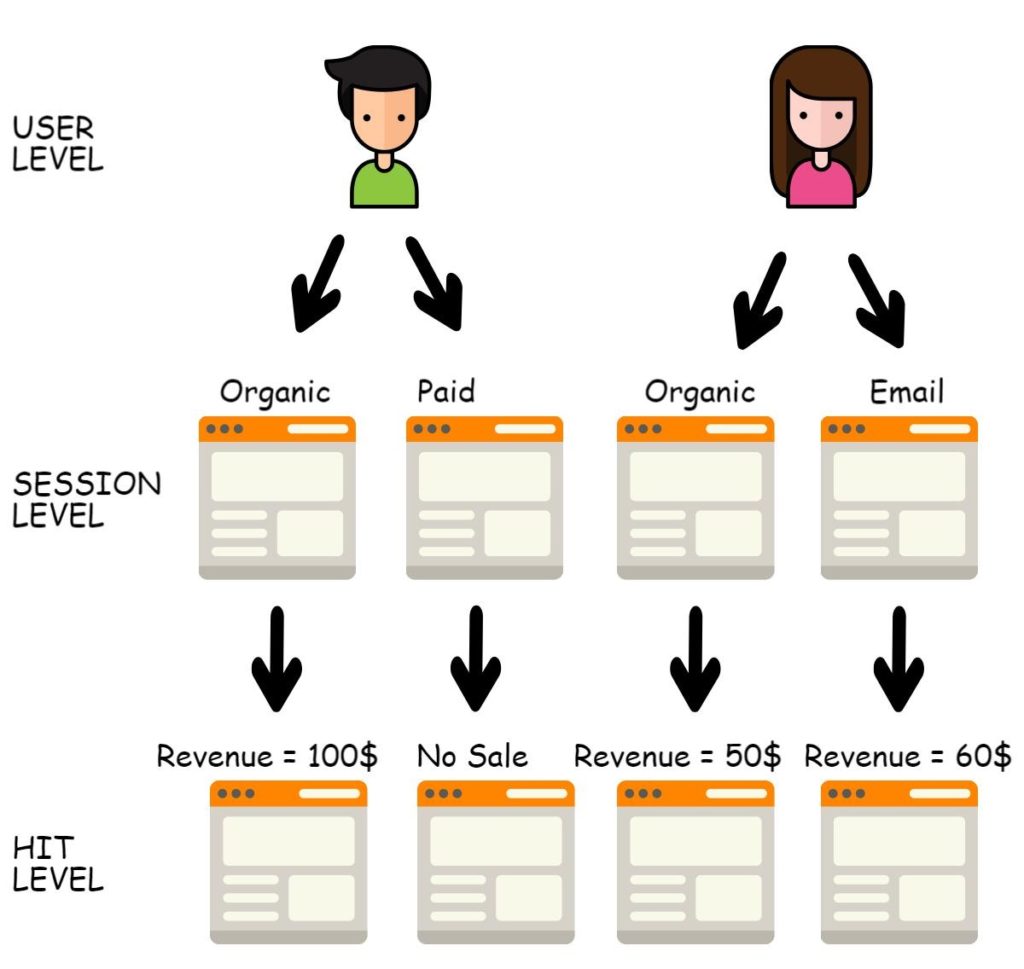
- Here, the first user came through Organic channel & purchased a product of 100$.
- Later, returned through Paid channel & did not purchase on 2nd visit.
- Second User came via Organic & purchased a product worth 50$
- Later returned via Email channel & purchased product worth 60$
Total (All Users Segment) Stats would be shown as-
- USER : 2
- SESSIONS : 4
- REVENUE : 210$
Lets, Create some segments & analyze the stats.
Segment 1: Users Having Revenue > 100$
- USER : 1 (2nd User)
- SESSIONS : 2
- REVENUE : 120$
Segment 2 : Sessions Having Revenue > 90$
- USER : 1 (1st User)
- SESSIONS : 2
- REVENUE : 100$
Segment 3 : Sessions Having Channel = Organic
- USER : 2 (Both Users)
- SESSIONS : 2
- REVENUE : 150$
Segment 4 : Users Having Channel = Organic
- USER : 2 (Both Users)
- SESSIONS : 4
- REVENUE : 210$
I guess now you understood how these Sessions / Users filter work.
Let’s start with usecases.
#1 User Segmentation Based on Transaction
You all might have heard the 80-20 rule.
- 80% of output comes from 20% of input
- 80% of happiness comes from 20% of your friends.
- 80% of returns will come from just 20% of all the channels.
- & so on…..
Here, it can be applied as
80% of all the revenue comes from 20% of the users.
So, if you have an ecommerce site, recharge site, coupin site, etc where you get recurring revenue from users.
You can create a 3 User segments. (All are mutually exclusive)
- Add to Carts – Abandoned (Add To Cart > 0 & transactions = 0)
- 1 Purchase Users (transaction = 1)
- 1+ Purchased Users (transaction > 1)
Here’s how it looks. (The report for last 3 months)
Note: Click on image below to enlarge.
If you observe closely, you can see All Users segment (which we normally look at Audience > Overview Report) gives us
- 166791 Users
- 46.32% Bounce Rate, 4.33 Pages/Session. 2:48 Avg. Session Duration
- 6472 transactions & 1,114,917$ revenue.
We can hardly infer anything from this data, lets use the above segments.
Now, observe the Add To Cart – Abandoned Users, there are
- 4939 Users ( ~6 % of Total) interested in buying but have dropped.
- 17.37% Bounce Rate, 9.9 Pages/Session & 7:16 Avg. Session Duration.
Check out the engagement..!!
We know that these users have well researched the product/website, have added products to the cart but have not bought due to some reasons.
1 Purchase Users segment defines Users who have transacted only once. We have
- 4939 Users ( ~3 % of Total) & they had revenue of 7,74,646$ (~70% of total revenue) in selected date range.
Similarly, for 1+ Purchase Users segment (transactions > 1) we have just
- 648 Users ( ~0.4 % of Total) having revenue of 3,40,271$ (~30% of total revenue) in selected date range.
You can see how only 3.4% (~3% + ~0.4%) of users complete your total 100% transactions.
I have made 2 different segments for purchasers because there are many users who make just one transaction & never return.
These 1+ Purchase Users Segment (just 0.4%!!) are your most loyal users & they will decide the fate of your company in the long run.
Now, the strategy part. We have push more users down the funnel.
i,e Add To Cart Users —-> 1 Puchase Users —> 1+ Purchased Users.
We can look at different channels bringing us the loyal users
Here, we can see, the % of 1+ Purchased Users out of total.
- Google Organic : 100 / 91656 = ~ 0.1%
- Google Cpc : 28/5667 = ~0.5%
- Bing Organic : 0 / 476 = 0%
You can focus on the channels bringing in more 1+ purchased users.
Also in google / cpc, try to deep dive more on dimensions like
- Campaign
- Keywords
- Device
- City
- & so on
to know more for the source of these 1+ Purchased Users.
Here, is the funnel for the device report
Desktop : 637 / 107731 = ~0.6%
Mobile : 11 / 50725 = ~ 0.02%
Tablet : 0
You can furthur break down by OS, Device Name, etc
Summary:
- The data for the revenue, transactions, etc depends on the Date Range applied.
You can create a custom dimension for range of revenue values.
Here’s a great method by metric mogul. - Sampling might be a problem for longer date ranges & large datasets.
- Try these segments across various dimensions such as Channels, Device, Landing pages, Browser, City, Pages etc to know more about your loyal users
- You can use different strategies for different buckets of users.
- If you have the email, phone no of users (1 purchase & 1+ purchase users), you can run email marketing campaigns, SMS campaigns, marketing automation, etc
- If you don’t have user info, you can try Remarketing across different ad networks such as google, facebook, bing, etc.
Try using Feedback Forms, Chat bots, LeadQuizzes, Website Recording, Heatmaps & so on.
#2 Session Segmentation using Count of Visit/Session
Count of Session/Visit is simply the Nth visit of the user.
It is also date independent dimension. To know more check : Count of Session – Google Analytics.
Here, we want to know what is the behavior of users on their 1st visit, 2nd visit, 3rd visit, etc.
We can only create 4 segments max, so we can create range of count of session. . Here are the segments.
- Sessions with 1st visit. (Count of session = 1)
- Sessions with 2-5th visit (Count of session > 1 & < 6)
- Sessions with 6+ visit (Count of session > 5)
Observe here I used Sessions instead of Users. (For Eg: If I select Users with 1st visit, then it will include all the sessions in the date range.)
Let’s look at Source / Medium report with ‘Ecommerce Tab’
- You can see as the Count of Visit increase the probablity of conversion(Conversion Rate) increases too.
- Similar is the case for Avg. Order Value, more visits = more probablity of converting for costly product.
- Session Value is also greater for users with 5+ visit.
Similar analysis can be made across Channels Reports, Device Reports & Landing Pages Reports.
That’ll help us understand:
- Maybe the ad copy was good OR
- Particular device has good UI & contributes to more returning visits & engagement OR
- Some landing page message made sense.
Here I have copied the same source / medium report & added device as dimension.
- Here Desktop wins in both the Conversion rate & Avg. order value.
- Mobile has a better conversion rate & avg. order value for 5+ visit users.
Try doing the math based on CPC & what is cheaper desktop or mobile & their returns.
Summary:
- Once you analyze the user behavior across different channels, devices, landing pages, you can deduce a strategy to increase your ROI.
- If Users have high conversion rate on 1st visit as compared to subsequent ones, focus more on New User Acuisition.
- If its other way round focus on remarketing. You can focus on bringing user more often to your website via remarketing, email campaigns, offering freebies, etc.
- You can also create a custom report with Count of Session as a primary dimension to know stats of all the visits. Eg:
- You can now check Conv. rate & Avg. order value across all the user visits.
- Also, check if the bounce rate if it is too high for
the First Visit (if it is check your targeting settings or landing pages) or Subsequent Visit. (if it is focus on acquiring new users, etc)
- Also, try using the dynamic Bar Chart (rarely used) to know how the metrics like conv. rate change across date range.
#3 Session Segmentation Based on Time of the day
As the name suggests we can group the sessions based on time of the day.
I’ll apply four segments
- Morning Users (6am to 12pm)
- Afternoon Users (12pm to 5pm)
- Evening Users (5pm to 8 pm)
- Night Users (9pm to 5am)
Feel Free to change the segment conditions as per your requirements.
Let’s look at source / medium report. (last 3 month date range)
- Observe when users are comfortable buying. You can check for Conversion Rate & Avg. Order Value across Hour of day.
- Here, Conversion Rate & Avg. Order Value is more Afternoon Sessions.
Now, you can simply focus more marketing budget on the Afternoon Time Period.
You can even check the sources for Higher Conv. Rate & Avg. Order Value across segments.
Observations:
- Conv. Rate is more for google/cpc & google/organic.
- Now, you can deduce a strategy & focus more on investing more on those channels & bring more traffic in Afternoon period, etc
Similarly, below are the same segments with Device as dimension.
You can analyze the user behavior across devices for different times in a day.
Observations:
- Here, Conv. Rate & Avg. Order Value is more for desktop.
- While mobile & tablet have less conv. rate, we can focus more on desktop sessions.
Summary:
- You can adjust the time filter in the segments as per your needs.
- Don’t draw any conclusion early based on just one report.
- Analyze the segments across various dimensions such as source/medium, device, city/country, landingpage, adwords campaign.
- Make sure to use date range in multiple of weeks. (so as to have equal sundays, mondays.., etc)
#4 User Segmentation Based on Events
This is my one of the most favorite segments.
The thing is many of us track things like free ebooks downloads, newsletters subscribers, Banner clicks, Video Viewers, etc
Don’t you want to know How many of them complete your main goal??
So, here we’ll create some of the user segments based on events:
- Users who clicked on Product Links
- Users who added Products to Wishlist
- Users who filled Contact Us form
Here these segments are not mutually exclusive. (i.e User can complete 1 or more events.)
Here’s a source medium report with ecommerce tab‘
Observations:
- Add To Wishlist & Product Clicked Users have more conversion rate (~9%) as compared to average 2.96%.
- Also Session Value is greater for those users.
Here, you can define user segments based on the micro goals/events & know how many of them complete macro goal.
Now you know the next process..
Focus on channels bringing those Users by using these segments in source / medium report.
Then also check for these following dimensions:
- Device
- City
- Landing Page
Here’s a sample screenshot for device reports.
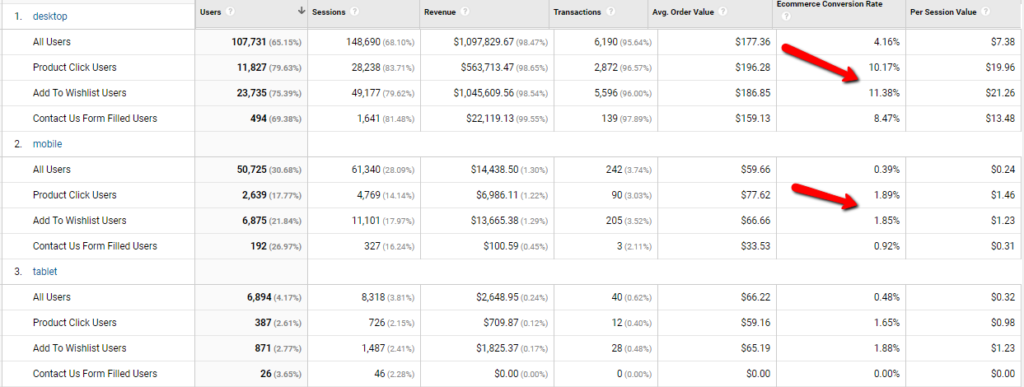
Observation:
- Desktop has more conversion rate (~10.5%) for Add to wishlist & Product Click Users.
- Mobile has low conv. rate (~2%).
You can allocate more spends to the device that converts well.
Summary
- While creating segment make sure you have similar sample size across all of them.
Eg: Some segment having 100 users & 10% Conv. Rate is NOT better performing than other segment having 10,000 users & 8% Conv. Rate. - The data always depends upon the date range applied. For larger date range, its always good to export data from analytics & use tools like Excel, R, python, etc for analysis.
- Always look at the combination of reports with different dimensions & segments to arrive at a conclusion or strategy.
Lastly, Let us know which of the segments you liked or have used earlier or recommend. Break it as 1.) Segments 2.) Analysis 3.) Strategy
